Dublin
- WT Travels
- europe
- April 2020
Wit and warmth are free gifts from most Dubliners. A charming accent coupled with intentionally mixed up pronunciation that softens the blow of the most vulgar American curse to ‘fek’ instantly turns frowns upside down. This is city of people that know how to grief sincerely, love generously, and share just about all they have with the rest of the world. A playground for highly educated city folk who want to have fun, the gorgeous Georgian architecture, farm-to-fork flourishing foodie culture, 5000 year old Celtic history, and within a stone’s throw mountains and cliff walks, make Dublin a worthy of exploring world class city.
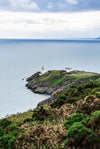

A forty-minute commuter train from Dublin center takes visitors to the Irish fishing village of Howth. Stroll and hike the spectacular verdant green trails to glimpse the 1667 Baily Lighthouse, breathe the salty air, and experience the rush of lush, sweeping land and seascapes. It is quiet here. Even with tourists, this Dublin escape is serene. Bring a blanket and a picnic basket. This is a place where you take your time to wonder and listen to the seagulls squawking and the wind whistling.
The heart of Trinity College is the 18th-century Old Library with its Long Room of 200,000 books shelved on oak bookcases, each end column featuring a marble bust of a famous philosopher…writer sculpted by Peter Schemakers during the mid-1700s. The emblem of Ireland, the harp, is modeled after the 15th-century Gaelic, wire strung wooden harp that has been on display in the library since 1792 and now graces Euro coins and beer bottles.
The most compelling reason to visit Trinity College’s library, however, is for the extraordinary illuminated manuscript known as The Book of Kells. The book’s extraordinary Celtic and Christian iconography and unique designs are firmly rooted in Irish identity and share the four gospels and the life of Jesus Christ. Thought to have been created around 800 A.D. by Christian monks on the isle of Iona in Scotland, “it is named for the monastery at Kells, County Meath, where the monks took refuge after a Viking raid and which became the manuscript’s home for centuries.”
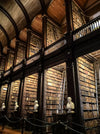
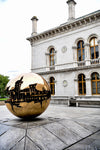
On campus, visit the Sfera con Sfera, a bronze sculpture reflecting everything around it, and Arnaldo Pomodoro’s vision of the relationship between Earth and Christianity, imperfection and perfection, hope and despair.

When in Dublin do as Dubliners do—go to Glencullen on the top of the picturesque Dublin Mountains for a quirky experience that includes a ‘famine pot’—an original giant cast iron kettle from which soup was ladled to feed the starving Irish during the Great Hunger of 1847. A Jonnie Fox’s hooley is the perfect intersection of storytelling, Celtic music, and traditional folk dancing.
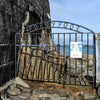
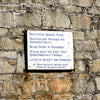
A Dublin institution immortalized in James Joyce’s Ulysses, The Forty Foot is a year round nippy Irish Sea bathing pool on the southern tip of Dublin Bay. For more than 250 years, city swimmers, men only, mostly nude, until twenty years ago, have braved the nippy waters at Sandy Cove that divide Ireland from Great Britain, taken the plunge and come out with little more to say than, “that was feckin’ freezing!” Voted by the New York Times as one of the best swimming spots in the world, it is also one of the most beautiful spots to linger and watch the natives dive the cliffs, even at low tide, and in spite of the shocking cold, come up all Irish smiles.

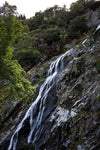


May the road rise up to meet you.
May the wind always be at your back.
May the sun shine warm upon your face,
and rains fall soft upon your fields.
And until we meet again,
May God hold you in the palm of His hand.
A 6th century monastic settlement founded by a descendent of the royal house of Leinster, the Gaelic kingdom that ruled Ireland from 632 to 1632. St. Kevin rejected his noble privilege to become a hermit and live in this lush green valley between two lakes carved out by glaciers during the Ice Age.

These are serene grounds and the subject of centuries old Irish folklore and Nobel prize winning poet Seamus Heaney’s St Kevin and the Blackbird. In it, Kevin holds out his hand with trance-like stillness while a blackbird builds a nest in it, lays eggs, the eggs hatch, and the chicks fledge. Exploring these hollowed grounds of ancient ruins and Celtic tombstones tests the fine line between reality and imagination.
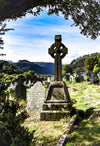

The Dubliners by James Joyce
The Sea by John Banville
The Picture of Dorian Gray by Oscar Wilde



In the shadows of the magnificent formal gardens of Powerscourt, Mount Usher Gardens are a local treasure of romantic flowers, shrubs, and trees informally arranged along the River Vartry.
In the land of saints and scholars, a mighty tome of entertainment spotlights the rich cultural traditions,educational excellence, and a 10,000 year old history filled with religion, war, strife, folklore, fairies, and fiddle music, Nobel prizes, Oscars, and Grammys. Founded by the Vikings in 980 and and then while much of Europe plunged into the Dark ages, Christianity provided a beacon of light with literate priests moving to the island sanctuary and continuing to build their bank of knowledge by reading and copying by hand the bible and other ancient texts. Dublin was and remains the Emerald Isle’s center of intellectual and artistic activity.